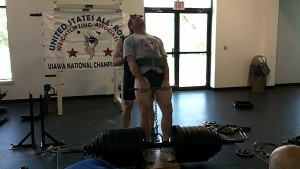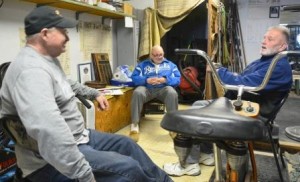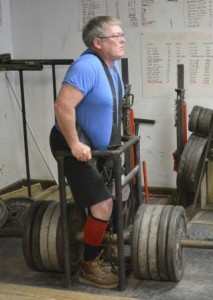By Eric Todd
HEAVY LIFT CHAMPIONSHIP – THE HAND AND THIGH

Joe Garcia pulls a big hand and thigh at the Heavy Lift Championship at York
(Due to the Corona virus, as of right now no official decision has been made on the Heavy Lift Championships. We will keep an eye on the situation and make a decision before long. As of right now, I am proceeding as though it will go on, but will keep the membership informed)
The Hand and Thigh will be the second lift contested in the Heavy Lift Championship, which is being contested on May 9th this year. When I last hosted in 2018, this was the article I posted regarding the execution of the lift: Hand and Thigh
I am not going to go so far as to say the hand and thigh has a richer past outside of IAWA/USAWA than the neck lift, but it certainly has a more well documented past. Many of the Old Time strongmen of past used the hand and thigh as part of their routine. This very lift was one of those contested when John B. Gagnon bested Warren Lincoln Travis for the unofficial title of World’s Strongest Man as mentioned in my last article on the neck lift. It was also included in Travis’s “Challenge to the World,” which was included as part of his will upon his death in 1941. This challenge included 10 feats that must be performed, including several that were repetition lifts, within 30 minutes. One of the items on the list is a single successful effort with a 1600 pound Hand and Thigh. The man who successfully completed the challenge would be awarded Travis’s “diamond-jeweled gold and silver” championship belt. To date there have been no takers.
Travis had a protégé by the name of Charles Phelan who, like Travis, performed his feats at Coney Island, New York. One of the lifts he performed on Coney Island was the Hand and Thigh, where he was credited with a lift of 1125 pounds. Phelan was also known for his capacity to entertain, as he would tell jokes between his feats of strength.
The famous Canadian strongman, Louis Cyr is credited with a lift using the hand and thigh method of 1897.25 pounds. More recently, a strongman who was inspired by Cyr performed the hand and thigh out in New Jersey. His name was Jack Walsh, and he claimed a hand and thigh of 1500 pounds around 1950. Iowa strongman Archie Vanderpool claimed a lift of 1840 pound in the hand and thigh. He utilized the method of a bar through two barrels to get the weight up in lieu of the big bar attached to a chain method that we use in the USAWA today. When I first saw a picture of him using this style, it seemed familiar. That is because I had seen Milo author, and renegade strongman, the heavy metal iron master himself, Steve Justa using that method in the book “Rock, Iron, Steel” that he authored. Apparently, Justa’s father was a friend of Vanderpool. In the book, Justa claims to have lifted over a ton using this method on multiple occasions. While he did compete at least once in the USAWA (it was a Kevin Fulton meet back around the time I was first getting started in the all-rounds), I do not believe he has ever performed this lift in competition. I am sure that is a rather abbreviated record of old time strongman performers who have been known for the hand and thigh lift.
That brings us to the hand and thigh lifting done in the USAWA, which, from any meet I have witnessed was done under professional judging within strict guidelines. In the Women’s class I am including any lifter who has gone 600 pounds or more. Our number one here, Armorkor Ollennuking is in a league of her own with 1100 pounds in this discipline:
1) Armorkor Ollennuking 1100 pounds 1997 Zercher
2)Jacqueline Simonsen 810 pound 1994 Nationals
3) Cara Ciavattone 702 pounds 1996 New England Championships
4) Jaenne Burchette 700 pounds 1991 Nationals
5)Mary Jo McVey 605 pounds 1993 Worlds
6) Jenna Lucht 600 pounds 2014 Old Time Strongman Championship
7) Amy Burks 600 pounds 1998 Zercher
For the men, I am including lifters who have gone 1400 pounds or better. Again, our leader is in a class of his own, with Joe Garcia hitting 1910 pounds:
1) Joe Garcia 1910 pounds 1997 Zercher
2)Frank Ciavattone 1610 pounds 1995 New England Strongman
3) Eric Todd 1510 pounds 2015 Heavy Lift Championship
4) Al Myers 1505 pounds 2010 Deanna Springs Memorial
5) Jim Malloy 1400 pounds 1995 Worlds
6) John Carter 1400 pounds 1996 Zercher
7) Steve Schmidt 1400 pounds 2004 Backbreaker
8) Sam Huff 1400 pounds 2005 Deanna Springs Memorial
9)Joe Ciavattone Jr. 1400 pounds 2013 Heavy Lift Championship
The Hand and Thigh has a rich history both in old time strongman performances and the USAWA. I am sure we will add to that history at this year’s Heavy Lift Championship.
Justa, Steve. “The Hand and Thigh Lift or the Quarter Deadlift.” Rock Iron Steel: the Book of Strength, IronMind Enterprises, 1998, p. 52.
“Louis Cyr.” <i>Wikipedia</i>, Wikimedia Foundation, 4 Mar. 2020, en.wikipedia.org/wiki/Louis_Cyr.
Murray, Jim. “Jack Walsh — World’s Strongest Man?” Iron Game History, vol. 4, no. 5, Oct. 1995, pp. 10–11.
Myers, Al. “Hand and Thigh Club.” USAWA, 2 Aug. 2011, usawa.com/hand-thigh-club/.
PeoplePill. “Warren Lincoln Travis: Strongman – Biography and Life.” PeoplePill, peoplepill.com/people/warren-lincoln-travis/.
Wood, John. “Archie Vanderpool.” Www.oldtimestrongman.com, 12 Oct. 2017, www.oldtimestrongman.com/blog/2016/08/23/archie-vanderpool/.
Wood, John. “Charles Phelan and His GIANT Kettlebell.” Www.oldtimestrongman.com, 6 Dec. 2018, www.oldtimestrongman.com/blog/2018/12/05/charles-phelan-giant-kettlebell/.


